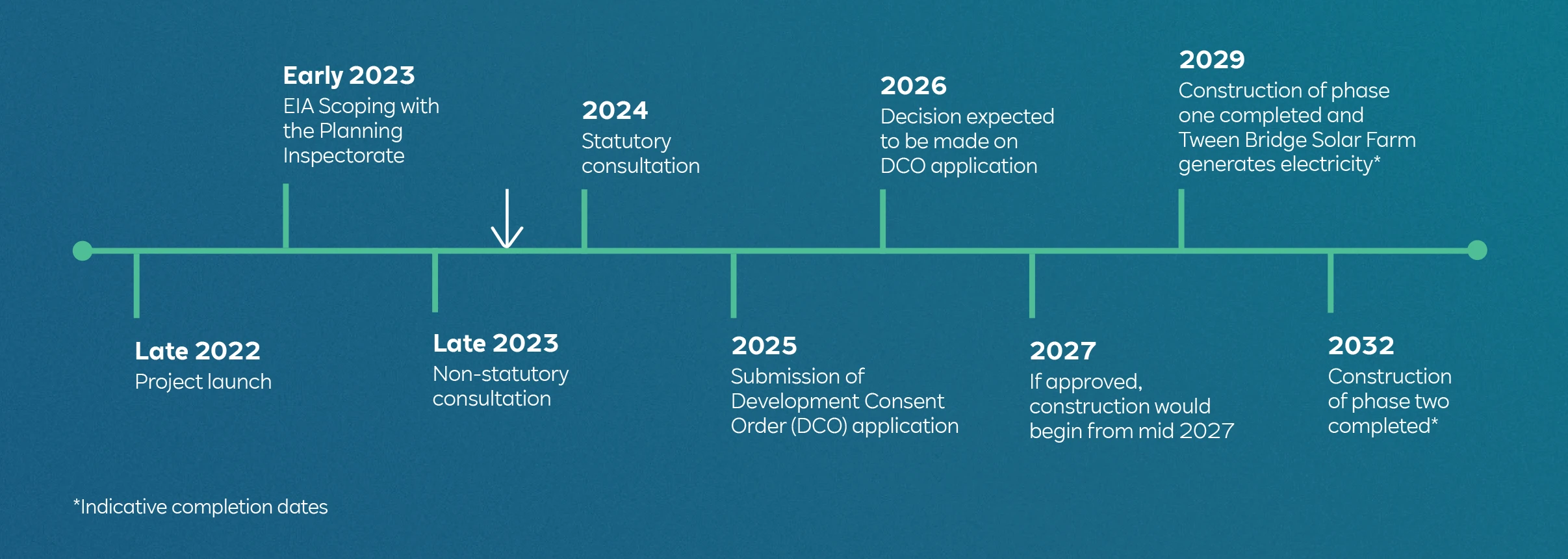Tween Bridge Solar Farm

FAQs
The Government’s recent Energy Security Strategy calls for a target of up to 70 gigawatts (GW) of solar electricity generation by 2035. This is an ambitious national challenge, and meeting the Government’s target for affordable, home-grown renewable electricity will require projects like Tween Bridge Solar Farm to be delivered around the country.
The government has committed to sustained growth in solar capacity to ensure that we are on a pathway that allows us to meet net zero emissions by 2050. Solar is a key part of the government’s strategy for low-cost decarbonisation of the energy sector. The British Energy Security Strategy states that government expects a five-fold increase in combined ground and rooftop solar deployment by 2035 (up to 70GW).
Government policy identifies how land type should not be a predominating factor in determining the suitability of sites. Where sites are located on agricultural land, government is supportive of solar that is co-located with other functions (for example, agriculture, onshore wind generation, or storage) to maximise the efficiency of land use.
The reason why this site has been chosen is due to an agreement with National Grid to connect Tween Bridge Solar Farm to the Drax-Keadby circuit, an existing National Grid 400kv overhead powerline which runs through the proposed site.
The proposals for Tween Bridge Solar Farm are a joint agreement with local landowners, many of whom are local farmers seeking to diversify their income.
We want to also reiterate that the land will still be productive with grazing and potential other dual use proposals. These activities, coupled with routine site maintenance will maintain employment on the land throughout the projects 40 year lifespan. Furthermore, unlike other developments (e.g housing), the land can be returned to full agricultural production after decommissioning.
Economic impact surveys will be undertaken and the results will be made available in the next iteration of our Preliminary Environmental Impact Report (PEIR).
Tween Bridge Solar Farm comprises a solar farm capable of generating up to 600MW of Alternating Current (AC) electricity with a co-located 400MW Battery Energy Storage System (“BESS”), enough green electricity to power over 240,000 homes*
* Calculation based on 2021 generation, and assuming average (mean) annual household consumption of 3,509 kWh, based on latest statistics from Department of Energy Security and Net Zero (Subnational Electricity and Gas Consumption Statistics Regional and Local Authority, Great Britain, 2021, Mean domestic electricity consumption (kWh per meter) by country/region, Great Britain, 2021)
Extensive ecological surveys have been carried out to assess the impact of the proposals on species in the local area. These surveys can be read in detail in the draft PEIR, Chapter 7 – Ecology and Nature Conservation.
Surveys carried out to date include:
- Baseline Habitats Report
- Breeding Bird Survey Report
- Non-breeding Bird Survey Report
- Nightjar Survey Reports
- Badger Survey Report [Circulation of Report is Restricted]
- Otter and Water Vole Survey Report [Circulation of Report is Restricted]
- Great Crested Newt Presence/Absence (eDNA) Survey Report
We are proposing Ecological and biodiversity measures across the entire site area. This includes the potential planting of new hedgerows, bolstering of existing field boundaries to increase coverage of this habitat, provide effective landscape screening, and to improve connectivity of the hedgerow and woodland network across and beyond the limits of the site. These proposals are being developed in conjunction with key environmental consultees.
The PEIR will be updated as further assessments become available and any update to the baseline will be reported in the next iteration of the PEIR which will be presented as part of the statutory pre-application consultation.
At this moment in time it is envisaged that construction will take place through either a single phase or a multiple of phases (i.e., phased approach to the construction of the solar arrays / development parcels). If all elements were constructed at the same time, then the construction phase would last up to 30 months.
Alternatively, the construction of the Scheme would coincide with the phased connection dates from National Grid. If this route is chosen, construction would occur in two phases, with phase one scheduled for completion in 2029, and phase two completed in 2032. The Environmental Statement will provide a full description of the potential construction, operational, management and decommissioning variances.
The priority at the scheme will be not producing waste in the first place with priority given to preparing waste for re-use, then recycling, then recovery, and last of all disposal.
All waste arisings transported off site would be delivered to the appropriately licenced receivers of such materials. Operators receiving any waste arisings would be subject to their own consenting procedures. It is not possible to forecast the capacity for final disposal for decommissioning at this stage due to potential change in waste regulations and legislation and generation and operators at that time.
The photovoltaic modules will be recycled or reused, where possible. With regards to the supporting structures, the structures will be unscrewed/unbolted, and then removed from the ground using a piling machine. Once the supporting structures have been removed, they will either be re-used or recycled, where possible.
Chapter 10 of the working draft PEIR identifies the potential impacts on the water environment from construction, operation and decommissioning. The water environment includes surface waterbodies (e.g. rivers, streams, ditches, canals, lakes and ponds, etc.), groundwater bodies, as well as flood risk and drainage.
The potential impacts on the water environment resulting from the Scheme focus on four main events:
- Erosion/sediment movement.
- Chemical/pollution events.
- Alteration/interruption of surface water flows.
- Alteration/interruption of ground water flows
A surface water drainage strategy will be implemented on site, which will manage the impact of the development on surface water run and prevent erosion and the discharge of silt-laden runoff from entering surface water drains, watercourses and ponds without treatment (e.g. earth bunds, silt fences, straw bales, or proprietary treatment) under any circumstances.
Surface water runoff from panels, equipment and access tracks will be directed to permeable Sustainable drainage systems (SuDS) features with contributions being made from permeable surfacing, wildflower planting and linear infiltration trenches.
Further surveys will be undertaken and used together with comments received from relevant consultees (e.g Doncaster Internal Drainage Board) to further refine and improve the proposals.
WHAT MEASURES WILL BE IMPLEMENTED IN THE BATTERY ENERGY STORAGE SYSTEM (BESS) TO MINIMISE FIRE RISK?
RWE recognises the use of batteries (including lithium-ion) as Energy Storage Systems (ESS) is a new and emerging practice in the global renewable energy sector. We are consulting with South Yorkshire Fire and Rescue (SYFR) to better understand any risks that may be posed and develop strategies and procedures to mitigate these risks.
To protect the battery energy storage system, it will be equipped with an FFSS (Fire Fighting Suppression System) inside each container. An FFSS includes a smoke detector, control panel, alarm device, exhaust pipe and bump head. It uses a clean fire suppression gas to minimize the second loss. Before gas blow-out, the system controller will send a signal to the HVAC main power switch to stop working as well as isolating the fans and thus achieve fire suppression process. RWE will continue to monitor developments in technological and regulatory advancements for BESS to ensure that the final design of the BESS complies with any future amendments to fire and safety standards.
Further information can be found in our draft PEIR: Chapter 16 – Other Environmental Topics.
RWE are committed to supporting the communities neighbouring our renewable energy projects through flexible community benefits packages. The proposals for Tween Bridge Solar Farm currently include a £2 million community benefit package for the local community. These plans are still at a very early stage of development, and the parameters of our community benefit package are still being finalised. One of the aims of our ongoing community consultation is to seek ideas for how we can structure our community benefit package.
We will be considering all feedback as we develop further details of the proposed community benefits. There will be a further opportunity to comment on more detailed community benefits proposals at our statutory consultation next year.
Our current design principles for the EV charging point include off street EV parking bays, a new dedicated access off Moor Edges Road, EV cabinets and new road signage.
More information will be included in the next version of the PEIR and made available at our next round of consultation, anticipated to be in summer 2024.
During the construction phase at the site, it is estimated that there will be around 609 on-site jobs created during an estimated 30-month construction phase, and for every job supported on site, indirect jobs are supported in the wider economy. It is estimated up to 810 off-site jobs could be supported during the construction phase.
Once operational, the scheme is estimated to support 23 direct and indirect full-time equivalent jobs in Doncaster and North Lincolnshire, 7 of those directly employed on site. Full-time jobs will be secured through continued agricultural use of the land underneath and around the solar arrays.
An Outline Supply Chain, Employment and Skills Plan will be produced to optimise the number of local people who will have access to employment and training opportunities. More details about this will be made available at our statutory consultation..
More information on our employment figures can be found in Chapter 11 of our draft Preliminary Environmental Information Report (PEIR) .
Between Wednesday 4 October and Wednesday 29 November, RWE Renewables’ are undertaking a first stage of ‘non-statutory’ consultation with local residents, organisations and other stakeholders to receive preliminary views on our draft proposals. Details on how to take part in our consultation can be found on the homepage.
RWE Renewables’ will consider and have regard to all responses received once the consultation has closed.
We will then refine the proposals further, before undertaking a second round of ‘statutory’ consultation, anticipated to be held in summer 2024.
Nationally Significant Infrastructure Projects (NSIPs) are major infrastructure developments in England. These include projects such as power plants, large renewable energy projects, new airports, airport extensions and major road projects.
Tween Bridge Solar Farm is classified as an NSIP due to it having a proposed generation capacity exceeding 50MW. We are therefore required to submit an application for development consent to the Planning Inspectorate (PINS). The Secretary of State for Energy Security and Net Zero decides whether to grant consent, in accordance with the Planning Act 2008.
A Development Consent Order (DCO) is the means of obtaining permission for developments categorised as NSIPs. This includes energy, transport, water and waste projects. This application will be made to PINS who will appoint an independent Examining Authority. The Secretary of State will decide whether to approve the application.
More information about the DCO process can be found here: https://infrastructure.planninginspectorate.gov.uk
The Planning Inspectorate (PINS) for England is an executive agency of the Department for Levelling Up, Housing and Communities of the United Kingdom Government with responsibility for making decisions and providing recommendations and advice on a range of land use planning-related issues across England.
More information on the DCO process can be found on the Planning Inspectorate’s website.

